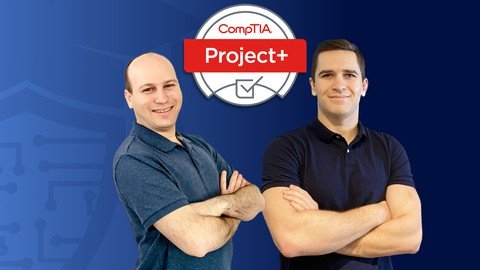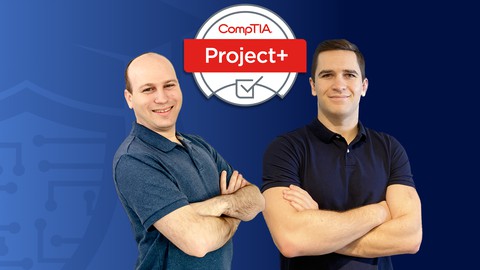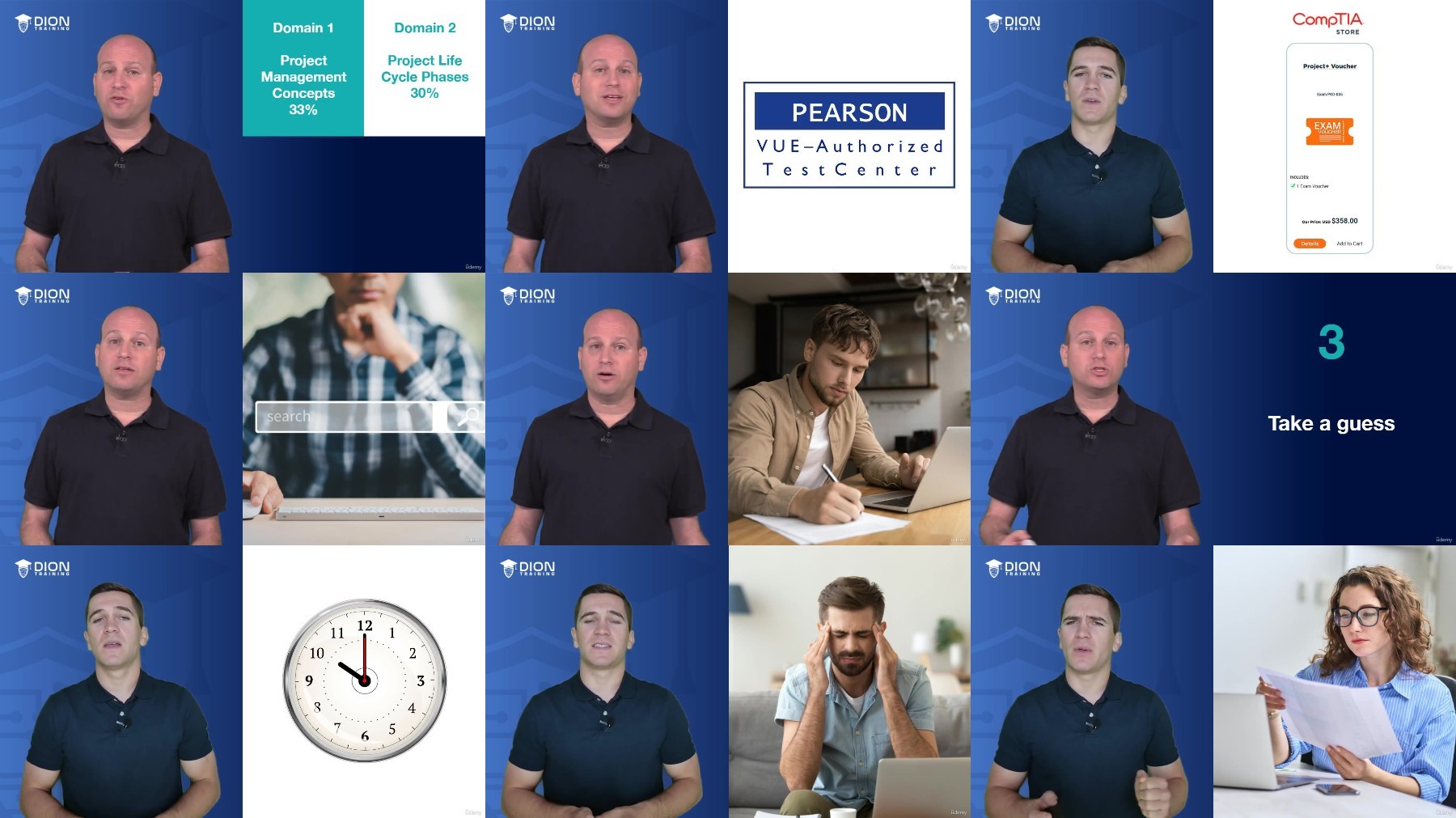
Free Download Comptia Project+ (Pk0-005) Complete Course & Practice Exam
Published 7/2023
MP4 | Video: h264, 1280x720 | Audio: AAC, 44.1 KHz
Language: English | Size: 10.03 GB | Duration: 16h 44m
Pass the CompTIA Project+ (PK0-005) exam on your 1st attempt, includes a full practice exam!
What you'll learn
Take and pass the CompTIA Project+ (PK0-005) certification exam
Understand project management concepts
Understand the project life cycle phases
Understand the appropriate project management tools to use throughout the project life cycle
Know the environmental, social, and governance factors impacting project management
Requirements
Basic understanding of project management
This course aligns directly to the CompTIA Project+ (PK0-005) Certification Study Guide
Description
*** Taught by a Best Selling IT Certification Instructor****This course provides everything you need in order to study for the*CompTIA*Project+ (PK0-005)*exam, including a downloadable Study Guide (PDF), quizzes to check your knowledge as you progress through the videos, and a full-length practice exam to test your knowledge before test day!Taught by an expert in information technology and cybersecurity with over 20 years of experience, as well as by an expert in data analytics and project management, this course is a fun way to learn what you need to know to pass the CompTIA*Project+ (PK0-005)*exam or to better prepare yourself to serve as a project manager in your organization.The CompTIA*Project+*(PK0-005)*certification is a vendor-neutral certification and a globally recognized credential that validates the knowledge and skills of professionals in project management. It focuses specifically on project management skills applicable to a wide range of industries and sectors. Getting this certification proves that you are a skilled project manager, with the necessary knowledge and abilities to handle projects of different sizes and levels of complexity. It opens doors to new opportunities, validates your expertise, and positions you for long-term success in the field of project management. The certification equips you with essential project management knowledge and skills, including project initiation, planning, execution, monitoring, and closure.This CompTIA*Project+ course will prepare students for the CompTIA Project+ PKO-005 certification exam and will provide students with the knowledge and skills required to manage the project life cycle, coordinate small-to-medium sized projects, establish a communication plan, manage resources and stakeholders, maintain project documentation and artifacts, and support the completion of larger projects within an information technology (IT) environment. The certification will cover both waterfall and agile project management methodologies.To help you practice for the CompTIA*Project+ (PK0-005) exam, this course even comes with a realistic practice exam containing 90 multiple-choice questions spread across the four domains tested by the CompTIA*Project+ (PK0-005) certification exam!This course will provide you with full coverage of the four domains of the CompTIA*Project+ (PK0-005)*exam
Overview
Section 1: Introduction
Lecture 1 Introduction
Lecture 2 Download the Study Guide
Lecture 3 Exam Tips
Lecture 4 Project Lifecycle
Section 2: Project Management Basics
Lecture 5 Project Management Basics (OBJ. 1.1 & 1.10)
Lecture 6 Project Management Skills (OBJ. 1.10)
Lecture 7 Benefits of Project Management (OBJ. 1.1)
Lecture 8 Types of Work (OBJ. 1.1)
Lecture 9 Organizational Structures (OBJ. 1.10)
Lecture 10 Roles and Responsibiltiies (OBJ. 1.1)
Lecture 11 Programs and Portfolios (OBJ. 1.10)
Section 3: The Business Case
Lecture 12 The Business Case (OBJ. 2.1)
Lecture 13 Current State and Future State (OBJ. 2.1)
Lecture 14 Financial Impact (OBJ. 2.1)
Lecture 15 ESG Factors (OBJ. 4.1)
Section 4: Methodologies and Frameworks
Lecture 16 Methodologies and Frameworks (OBJ. 1.1)
Lecture 17 Waterfall (OBJ. 1.1)
Lecture 18 Agile (OBJ. 1.1)
Lecture 19 Scrum (OBJ. 1.1)
Lecture 20 Kanban (OBJ. 1.1)
Lecture 21 Extreme Programming (OBJ. 1.1)
Lecture 22 DevOps & DevSecOps (OBJ. 1.1)
Lecture 23 Scaled Agile Framework (OBJ. 1.1)
Lecture 24 Software Development Life Cycle (OBJ. 1.1)
Lecture 25 PRINCE2 (OBJ. 1.1)
Section 5: Comparing Waterfall and Agile
Lecture 26 Comparing Waterfall and Agile (OBJ. 1.2 & 1.10)
Lecture 27 Product Ownership (OBJ. 1.2 & 1.10)
Lecture 28 Team Composition (OBJ. 1.2 & 1.10)
Lecture 29 Communication (OBJ. 1.1 & 1.10)
Lecture 30 Requirements (OBJ. 1.1 & 1.10)
Lecture 31 Budget and Schedule (OBJ. 1.1 & 1.10)
Lecture 32 Environmental Factors (OBJ. 1.1 & 1.10)
Section 6: Initiating The Project
Lecture 33 Initiating the Project (OBJ. 1.10)
Lecture 34 Team Roles and Responsibilities (OBJ. 1.10)
Lecture 35 Building the Project Team (OBJ. 1.10 & 2.2)
Lecture 36 Responsibility Assignment Matrix (OBJ 1.10 & 3.1)
Lecture 37 Stakeholder Engagement (OBJ. 1.10 & 2.2)
Lecture 38 Project Initiation Documents (OBJ. 1.10 & 3.1)
Lecture 39 Performance Measures & Timeline Charts (OBJ. 1.10 & 3.1)
Lecture 40 Project Charter & Scope Statement (OBJ. 1.10, 2.2, & 3.1)
Lecture 41 Records Management (OBJ. 1.10, 2.2, & 3.1)
Lecture 42 Kickoff (OBJ. 1.10 & 2.2)
Section 7: Facilitating Effective Meetings
Lecture 43 Facilitating Effective Meetings (OBJ. 1.8)
Lecture 44 Communication Methods (OBJ. 1.8 & 1.9)
Lecture 45 Communication Challenges (OBJ. 1.8 & 1.9)
Lecture 46 Meeting Roles (OBJ. 1.8 &1.9)
Lecture 47 Informative Meetings (OBJ. 1.8 &1.9)
Lecture 48 Decisive Meetings (OBJ. 1.8 & 1.9)
Lecture 49 Collaborative Meetings (OBJ. 1.8 & 1.9)
Lecture 50 Meeting Artifacts (OBJ. 1.9 & 1.10)
Lecture 51 Conflict Management (OBJ. 1.8, 1.9, 1.10, & 2.3)
Section 8: Project Management Tools
Lecture 52 Project Management Tools (OBJ. 1.9, 1.10, & 3.2)
Lecture 53 Installation Options (OBJ. 1.9, 1.10, & 3.2)
Lecture 54 Meeting Tools (OBJ. 1.9, 1.10, & 3.2)
Lecture 55 Productivity Tools (OBJ. 1.9, 1.10, & 3.2)
Lecture 56 Common Diagrams (OBJ. 1.9, 1.10, & 3.2)
Lecture 57 Collaboration Tools (OBJ. 1.9, 1.10, & 3.2)
Lecture 58 Communication Tools (OBJ. 1.9, 1.10, & 3.2)
Lecture 59 Elements of a Communication Plan (OBJ. 1.9 & 1.10)
Lecture 60 Develop a Communication Plan (OBJ. 1.9 & 1.10)
Lecture 61 Build an Escalation Plan (OBJ. 1.9 & 1.10)
Lecture 62 Maintain Communication Records (OBJ. 1.9 & 1.10)
Section 9: Implementing Solution Design
Lecture 63 Implementing Solution Design (OBJ. 3.3)
Lecture 64 Solution Design Overview (OBJ. 2.2 & 3.3)
Lecture 65 Solution Design Example (OBJ. 2.2 & 3.3)
Lecture 66 Solution Design Approach (OBJ. 2.2 & 3.3)
Lecture 67 Solution Design in an Agile Project (OBJ. 2.2 & 3.3)
Lecture 68 Diminishing Returns and the Pareto Principle (OBJ. 3.3)
Lecture 69 IT Infrastructure (OBJ 4.4)
Lecture 70 Data Classification and Handling (OBJ. 4.2 & 4.3)
Lecture 71 Operational Security (OBJ. 4.2 & 4.3)
Section 10: Managing Resources
Lecture 72 Managing Resources (OBJ. 1.10)
Lecture 73 Types of Resources (OBJ. 1.10)
Lecture 74 Resource Sourcing and Allocation (OBJ. 1.10, 2.3, & 3.3)
Lecture 75 Calculating Shared Resource Capacity (OBJ. 1.10, 2.3, & 3.3)
Lecture 76 The Resource Lifecycle (OBJ. 1.10, 2.3, & 3.3)
Lecture 77 Conduct a Needs Assessment (OBJ. 1.10, 2.3, & 3.3)
Lecture 78 Gap Analysis (OBJ. 1.10, 2.3, & 3.3)
Lecture 79 Resource Optimization (OBJ. 1.10, 2.3, & 3.3)
Lecture 80 Common Diagrams (OBJ. 1.10, 2.3, & 3.3)
Lecture 81 Resource Management Process (OBJ. 1.10, 2.3, & 3.3)
Section 11: Managing Risk
Lecture 82 Managing Risk (OBJ. 1.4 & 1.5)
Lecture 83 Comparing Risk, Issues, and Changes (OBJ. 1.4 & 1.5)
Lecture 84 Risk Management Overview (OBJ. 1.4 & 1.5)
Lecture 85 Interval vs External Risk (OBJ. 1.4, 1.5, & 2.3)
Lecture 86 Qualitative Risk Analysis (OBJ. 1.4, 2.3, & 3.1)
Lecture 87 Quantitative Risk Analysis (OBJ. 1.4, 2.3, & 3.1)
Lecture 88 Risk Management Strategies (OBJ. 1.4, 2.3, & 3.1)
Lecture 89 Mitigation and Contingency Plans (OBJ. 1.4, 2.3, & 3.1)
Lecture 90 Transition Plans (OBJ. 1.4, 2.3, & 3.1)
Section 12: Creating a Project Schedule
Lecture 91 Creating a Project Schedule (OBJ. 1.6)
Lecture 92 Milestones (OBJ 1.6 & 2.3)
Lecture 93 Project Cadence (OBJ. 1.6 & 2.3)
Lecture 94 Work Breakdown Structure (OBJ. 1.6 & 2.3)
Lecture 95 Creating the WBS (OBJ. 1.6 & 2.3)
Lecture 96 Project and Product Backlog (OBJ. 1.6 & 2.3)
Lecture 97 Project Tasks (OBJ. 1.6 & 2.3)
Lecture 98 Dependencies (OBJ. 1.6 & 2.3)
Lecture 99 Estimation Techniques (OBJ. 1.6 & 2.3)
Lecture 100 Resource Allocation (OBJ. 1.6 & 2.3)
Section 13: Creating a Project Plan
Lecture 101 Creating a Project Plan (OBJ. 1.6)
Lecture 102 Project Network Diagrams (OBJ. 1.6 & 3.1)
Lecture 103 Critical Path Method (OBJ. 1.6 & 3.1)
Lecture 104 Usefulness of CPM Outputs (OBJ. 1.6 & 2.3)
Lecture 105 Minimum Viable Product (OBJ. 1.6 & 2.3)
Lecture 106 Project Reserves (OBJ. 1.6 & 2.3)
Lecture 107 Calculating Project Reserves (OBJ. 1.6 & 2.3)
Lecture 108 Project Baselines (OBJ. 1.7, 2.3, & 4.5)
Lecture 109 Project Budgets (OBJ. 2.3)
Section 14: Procuring Solutions
Lecture 110 Quality Assurance Plan Overview (OBJ 1.7, 1.10)
Lecture 111 Types of Software Tests (OBJ 1.7, 1.10, 4.5)
Lecture 112 Create a Test Plan (OBJ 1.7, 1.10)
Lecture 113 Project Management Plan (OBJ 1.7, 1.10)
Lecture 114 Procurement Process Overview (OBJ 1.11 & 2.1)
Lecture 115 Evaluating Solutions (OBJ. 1.11)
Lecture 116 Evaluation Techniques (OBJ. 1.11 & 2.4)
Lecture 117 Procurement Contracts (OBJ. 1.11 & 2.4)
Lecture 118 Contract Terms (OBJ. 1.11 & 2.4)
Section 15: Managing Project Execution
Lecture 119 Managing Project Execution (OBJ. 1.10)
Lecture 120 Project Momentum (OBJ. 1.10, 2.4, & 3.1)
Lecture 121 Requirements Traceability Matrix (RTM) (OBJ. 1.6, 1.10, 2.4, 3.1, & 3.3)
Lecture 122 Progress Tracking Tools (OBJ. 1.10, 2.4, & 3.1)
Lecture 123 Version Control (OBJ. 1.10, 2.4, & 3.1)
Lecture 124 Logs (OBJ. 1.10, 2.4, & 3.1)
Lecture 125 Burnup and Burndown Charts (OBJ. 1.10, 2.4, 3.1, & 3.3)
Lecture 126 Velocity and Throughput Charts (OBJ. 1.10, 2.4, 3.1, & 3.3)
Lecture 127 Meetings (OBJ. 1.6, 1.10)
Lecture 128 Providing Feedback (OBJ. 1.6, 1.10)
Section 16: Resolve Issues
Lecture 129 Resolve Issues (OBJ. 1.4, 1.5, & 1.6)
Lecture 130 Issue Management Overview (OBJ. 1.4, 1.5, & 1.6)
Lecture 131 Identify the Issue (OBJ. 1.4, 1.5, & 1.6)
Lecture 132 Analyze the Issue (OBJ. 1.4, 1.5, 1.6, & 3.3)
Lecture 133 Issue Prioritization Tools (OBJ. 1.4, 1.5, 1.6, & 3.3)
Lecture 134 Resolve and Monitor the Issue (OBJ. 1.4, 1.5, 1.6, & 3.3)
Lecture 135 Control Charts (OBJ. 1.4, 1.5, & 1.6)
Section 17: Control Change
Lecture 136 Control Change (OBJ. 1.3 & 4.5)
Lecture 137 Change Control Overview (OBJ. 1.3 & 4.5)
Lecture 138 Scope Change vs Scope Creep (OBJ. 1.3 & 4.5)
Lecture 139 IT Change Delivery Methods (OBJ. 1.3 & 4.5)
Lecture 140 IT Change Risk Mitigation (OBJ. 1.3 & 4.5)
Lecture 141 IT Environments (OBJ. 1.3 & 4.5)
Section 18: Managing Performance
Lecture 142 Managing Performance (OBJ 1.6)
Lecture 143 Scope and Budget Burndown Charts (OBJ 1.6, 1.7, 2.4, & 3.1)
Lecture 144 Project Performance Gap Analysis (OBJ 1.6, 1.7, 2.4, & 3.1)
Lecture 145 Contingency Reserve Utilization (OBJ 1.6, 2.4, & 3.1)
Lecture 146 Earned Value Management (OBJ 1.6, 2.4, & 3.1)
Lecture 147 Cost and Schedule Performance Metrics (OBJ 1.6, 2.4, & 3.1)
Lecture 148 Forecasting Performance (OBJ 1.6, 2.4, & 3.1)
Lecture 149 Rebaseline and Revise the Baseline (OBJ 1.6, 2.4, & 3.1)
Lecture 150 Project Dashboards (OBJ 1.6, 2.4, & 3.1)
Section 19: Wrapping Up the Project
Lecture 151 Wrapping Up the Project (OBJ. 2.4 & 2.5)
Lecture 152 Organizational Change Management (OBJ. 2.4 & 2.5)
Lecture 153 Connecting with End Users (OBJ. 2.4 & 2.5)
Lecture 154 Prepare for Project Closeout Reviews (OBJ. 2.4 & 2.5)
Lecture 155 Closing Phase Overview (OBJ. 2.4 & 2.5)
Lecture 156 Project Evaluation Overview (OBJ. 2.4 & 2.5)
Lecture 157 Project Closure Meeting (OBJ. 2.4 & 2.5)
Lecture 158 Project Closeout Report (OBJ. 2.4 & 2.5)
Lecture 159 Finish Resource Management Activities (OBJ. 2.4 & 2.5)
Section 20: Conclusion
Lecture 160 Conclusion
Lecture 161 BONUS: What comes next?
Students preparing for the CompTIA Project+ (PK0-005) Certification Exam,Business analysts,Project coordinators,IT project managers,IT managers,IT support managers
Homepage
Recommend Download Link Hight Speed | Please Say Thanks Keep Topic Live
No Password - Links are Interchangeable








